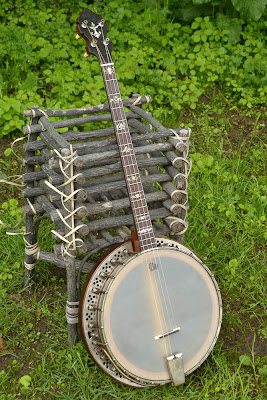c.1920 Lange-made Banner Blue Resonator Tenor Banjo
After this guy was all finished up, my first thought was, "what a nice old tenor!" It's got a sweet, warm, but focused sort of tone that's extremely useful if you're a chord-melody player or someone who plays a lot of backing chords in 20s/30s style. It's not brash or harsh at all but it's also not tubby and ill-defined or "weak" on the punchy side of banjo life. This is a hard sound to get out of a tenor without a mute on the bridge!
Work included a fret level/dress, much cleaning, new bone nut, tuner adjustments (new washers and ferrules), new bridge, new head, new neck brace shims, and setup. It plays really well and has only a tiny touch of relief (1/64" overall) so plays perfectly with a 1/16" action at the 12th fret.
The new Elite head looks great on this banjo. This is essentially the same as a regular Remo Renaissance head but it has a slightly-nicer integral flesh hoop on it.
This is a long-scale banjo with a 22 7/8" scale length and standard 11" head diameter.
There's plenty of pretty pearl inlay on this neck. The stuff in the headstock is in several colors and sure shines! Note the stenciled-on "Banner Blue" label at the top of the headstock and the very cool headstock shape.
The fretboard is bound in rosewood and the board itself appears to be dyed maple or pearwood. The frets are lower and smaller which is to be expected on old Langes. Still, they have plenty of life left.
Nice plated-brass Presto tailpiece. I used a new 2-foot ebony/maple Grover tenor bridge on this guy.
Also -- check out the top edge of that rim: you can see the good-sized brass tonering that gives this instrument such a nice, warm tonality. Of course, that multi-laminate big old maple rim and high-quality hardware helps, too!
This has such a classy "jazz era" look to it.
The rim's exterior has mahogany veneer on it and also has some nice inlaid wood stripes. The rim has a good one-piece bracket band that contributes plenty to rim stability.
At some point this had 4:1 geared pegs on it but those were removed long ago. In place are some plain-Jane ivoroid-buttoned friction pegs which work just fine.
Note how the neck is two-piece mahogany with a center strip of maple/dyed maple/maple. This makes is stronger and more stable than a regular one-piece neck.
The resonator is original and has some nice inlaid stripes but I'm pretty sure it has an extra layer of varnish applied. It doesn't look bad but doesn't have the same gleam and polish of the original top coat.
Here you can see that tailpiece again. With a small machine screw added it becomes (nominally) adjustable, but usually the little machine screw is found missing (as in this case) because it doesn't do much.
Also, check out that big old brass arm rest! I have absolutely no idea if that's original but it's certainly period. It feels great and looks really cool vs. the normal bigger/wider armrests which detract from the overall look of the instrument.
Here you can see the neck brace and the two new neck brae shims I made out of rosewood. These get hammered into place to set the neck to the pot.
As if we couldn't tell who made this by the overall design, look, and materials... it's stamped "Lange-Made" right on the dowel! FYI, Lange is William Lange, maker of Orpheum and Paramount banjos as supplied through Bruno in the 20s/30s.
There are four of these peculiar brackets inside the rim. I'm guessing they might have been part of either a muting apparatus or one of those tone-enhancer curios. Either way, whatever they were for is long gone.
...and here's the resonator on the inside!




















Comments